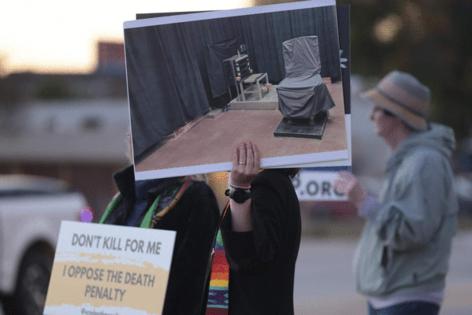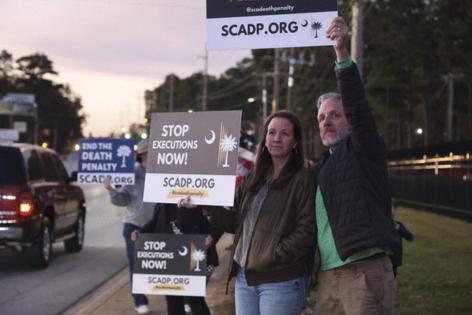Stephen Bryant becomes third person in South Carolina executed by firing squad
Published in News & Features
COLUMBIA, S.C. — Stephen Bryant, 44, was executed by firing squad inside the state death chamber in Columbia shortly after 6 p.m. Eastern time Friday.
Bryant pleaded guilty to death for the murder of Willard Tietjen who he killed during a bizarre and violent crime spree in Sumter, South Carolina, in October 2004. He also pleaded guilty to the murders of Cliff Gainey and Christopher Burgess as well as the attempted murder of Clinton Brown.
Over eight days, Bryant robbed homes, cutting the phone lines before stealing valuables and a gun. He shot Brown in the back and murdered Gainey, his co-worker, before setting fire to his trailer. He met Burgess by chance at a convenience store and within hours had shot him on the side of an isolated dirt road.
He took phone calls from Tietjen’s family members as he prowled their home and on the wall of the crime scene he scrawled “Victem 4 in 2 weeks. Catch me if u can,” in Tietjen’s own blood.
Bryant was only the third person to be executed by firing squad in South Carolina. The controversial method was introduced as part of a push to resume executions following a 13-year pause. The last execution by firing squad was marked by controversy when the condemned man, Mikal Mahdi, appeared to yell in pain on being shot. An autopsy found only two bullet entry wounds – South Carolina’s firing squad has three shooters all carrying loaded guns.
Bryant was the seventh person to be executed since South Carolina resumed carrying out the death penalty in Sept. 2024. In that time, he is the first to have been sentenced to death after pleading guilty.
His attorneys argued that he suffered from fetal alcohol syndrome and PTSD from repeated childhood sexual abuse from family and friends. But in their order denying Bryant’s final appeal, the South Carolina Supreme Court found that the planning and brutality of Bryant’s crimes outweighed his possible impairments.
In the weeks leading up to the murders, Stephen Bryant was trying to get help. He was 22 and had spent four of the last five years in prison. According to experts, Bryant had struggled in school and had a low IQ. Some experts also believe that he suffered from fetal alcohol syndrome in addition to PTSD, which meant he struggled to understand people’s intentions and perceived them as threats.
Bryant had recently confessed to his aunt and grandmother that he was struggling with flashbacks of his father beating him and of the alleged sexual abuse from his mother and grandfather, according to court records.
In the weeks leading up to the killings, his aunt remembered how he seemed to be in restless, angry turmoil. His body would shake so much the table he sat at would rock, according to her testimony.
Unable to pay the $75 needed to see a counselor, he deteriorated rapidly, according to his attorneys.
Bryant’s crime spree began in early October 2004 with a series of burglaries. He cased isolated homes, cut their phone lines and broke in. On Oct. 8, he stole the Smith & Wesson pistol he would use in his murders. That same day he shot Clinton Brown, a stranger, in the back while Brown fished beside a river.
Brown survived, but on Oct. 9, Bryant murdered Cliff Gainey and left his body on the side of a rural road. Bryant and Gainey had been co-workers and had socialized with each other’s families and even fished together. After the killing, Bryant returned to Gainey’s rented trailer and stole his TV, stereo and aquarium before setting it on fire.
Two days later, Bryant talked his way inside the home of Williard Tietjen, a 62-year-old disabled man with a heart condition and early onset Alzheimer’s. Bryant had met him earlier that week while pretending to search for his friend. The two spoke for several hours before Bryant killed Tietjen, stubbed a cigarette in his eye and burned his beard. Bryant prowled the home looking for valuables, and answered phone calls from his victim’s wife and daughter. He called himself the “prowler” and told them “T.J. is dead.”
Before leaving, he scrawled his message to the police in Tietjen’s blood, warning that he would kill again.
The final murder came two days later, after Bryant met Christopher Burgess by chance at a convenience store in the early morning hours. The two left together and within hours Burgess was found shot to death on the side of a country road.
Even if there was evidence of fetal alcohol syndrome, the South Carolina’s Supreme Court justices wrote “there is no reasonable probability the sentencing judge would have concluded the balance of aggravating and mitigating circumstances did not warrant death.”
©2025 The State. Visit thestate.com. Distributed by Tribune Content Agency, LLC.










Comments